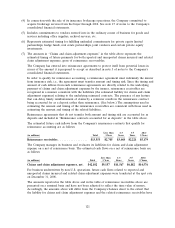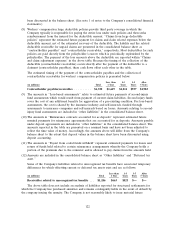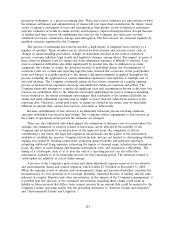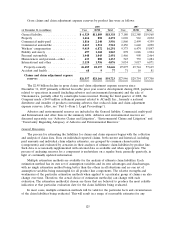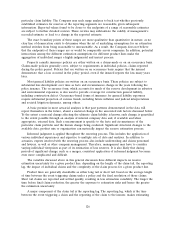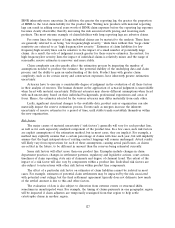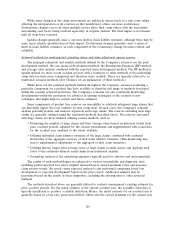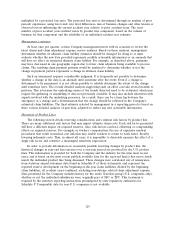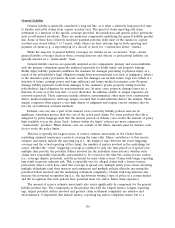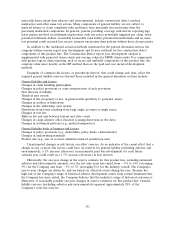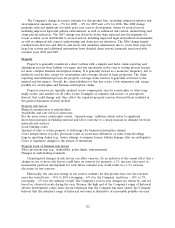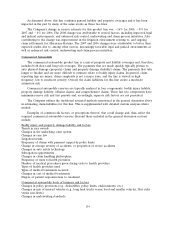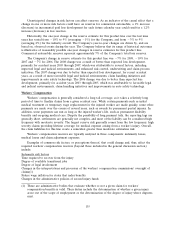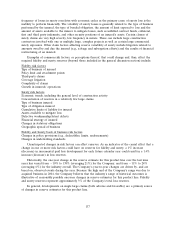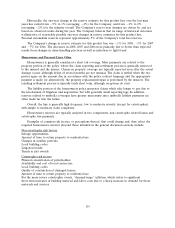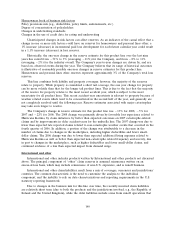Travelers 2008 Annual Report Download - page 143
Download and view the complete annual report
Please find page 143 of the 2008 Travelers annual report below. You can navigate through the pages in the report by either clicking on the pages listed below, or by using the keyword search tool below to find specific information within the annual report.
materially lesser extent than asbestos and environmental, include construction defect, medical
malpractice and other mass tort actions. Many components of general liability are not subject to
material latency or claim complexity risks and hence have materially less uncertainty than the
previously mentioned components. In general, policies providing coverage with shorter reporting lags,
fewer parties involved in settlement negotiations, only one policy potentially triggered per claim, fewer
potential settlement dollars, reasonably foreseeable (and stable) potential hazards/claims and no mass
tort potential result in much less reserve estimate uncertainty than policies without those characteristics.
In addition to the traditional actuarial methods mentioned in the general discussion section, the
company utilizes various report year development and S-curve methods for the construction defect
components of this product line. The Construction Defect report year development analysis is
supplemented with projected claim counts and average values for IBNR claim counts. For components
with greater lags in claim reporting, such as excess and umbrella components of this product line, the
company relies more heavily on the BF method than on the paid and case incurred development
methods.
Examples of common risk factors, or perceptions thereof, that could change and, thus, affect the
required general liability reserves (beyond those included in the general discussion section) include:
General liability risk factors
Changes in claim handling philosophies
Changes in policy provisions or court interpretation of such provisions
New theories of liability
Trends in jury awards
Changes in the propensity to sue, in general with specificity to particular issues
Changes in statutes of limitations
Changes in the underlying court system
Distortions from losses resulting from large single accounts or single issues
Changes in tort law
Shifts in law suit mix between federal and state courts
Changes in claim adjuster office structure (causing distortions in the data)
Changes in settlement patterns (e.g., medical malpractice)
General liability book of business risk factors
Changes in policy provisions (e.g., deductibles, policy limits, endorsements)
Changes in underwriting standards
Product mix (e.g., size of account, industries insured, jurisdiction mix)
Unanticipated changes in risk factors can affect reserves. As an indicator of the causal effect that a
change in one or more risk factors could have on reserves for general liability (excluding asbestos and
environmental), a 1% increase (decrease) in incremental paid loss development for each future
calendar year could result in a 1.5% increase (decrease) in loss reserves.
Historically, the one-year change in the reserve estimate for this product line, excluding estimated
asbestos and environmental amounts, over the last nine years has varied from 5% to 14% (averaging
5%) for the Company and from 3% to 7% (averaging 2%) for the industry overall. The Company’s
year-to-year changes are driven by, and are based on, observed events during the year. Because the
high end of the Company’s range of historical adverse development comes from certain businesses that
the Company has since exited, the Company believes that the industry’s range of historical outcomes is
illustrative of reasonably possible one-year changes in reserve estimates for this product line. General
liability reserves (excluding asbestos and environmental) represent approximately 28% of the
Company’s total loss reserves.
131


